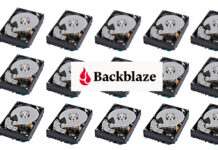Blocks & Files expects the rapid adoption of 96-layer QLC flash for fast-access, read-centric data storage applications, where its lower write endurance, compared to TLC flash, matters less. But will the take-up of QLC flash result in price declines for SSD memory?
That’s what happened with the arrival of TLC flash. This precipitated a fall in SSD $/GB prices in the summer of 2017, as the chart below shows.

TLC (3bits/cell) delivers a 50 per cent increase in capacity on MLC (2bits/cell) flash, which was the dominant technology until its arrival.
The arrival of 3D NAND in 2017 also contributed to lower prices. 3D NAND arranges multiple layers of cells to flash to increase capacity within a flash chip’s footprint.
Both technologies increased the bit capacity of flash chips and of the circular wafers from which flash chips are made. This in turn paved the way for price falls.
QLC in bits
So what about QLC? Here are some rough calculations to show what could happen.
QLC has 4bits/cell – a third more than TLC – and 96 3D layers, 50 per cent more than TLC’s 64 3D layer arrangement.
Combine these two effects – the increased bits and more layers, and the cost per bit of a 96-layer QLC cell compared to a 64-layer TLC cell, could be up to 50 per cent less.
I have not factored in QLC unit production costs and my calculations are for illustrative purposes only. They are not meant to be definitive. Nonetheless, my sources expect this to have a modest impact on pricing








